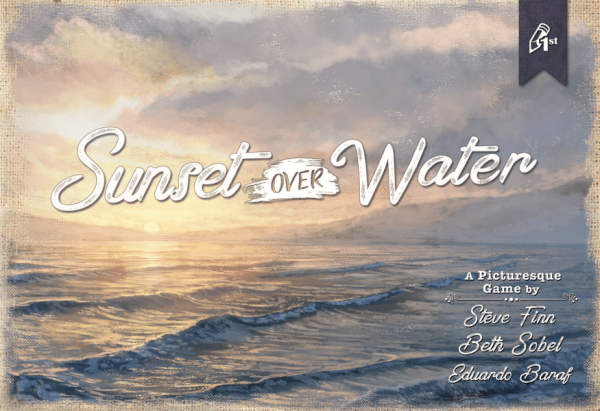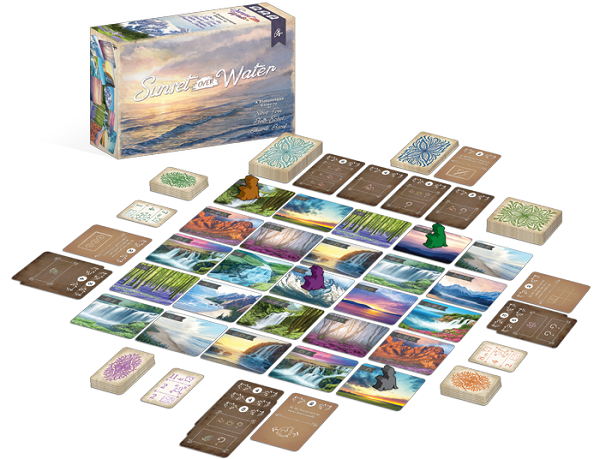Hike, Paint, and Be Inspired in Sunset Over Water

Take on the role of a painter, hiking through beautiful landscapes looking for the perfect scenes to capture in order to fill commissions and earn renown.
Published by Pencil First Games and designed by Steve Finn, with artwork by Beth Sobel (Wingspan, Calico, and Lanterns: The Harvest Festival to name just a few), Sunset Over Water is beautiful, relaxing, and clever all rolled into one.
Gameplay
The landscape deck is shuffled and twenty-five cards are dealt out onto the table, face-up, in a five-by-five grid. Each landscape features one to three different features (mountains, coast, waterfall, wildflowers, or sunset). Each player chooses an artist and places his artist meeple on the card in the center of the grid. Each player also takes a deck of planning cards. A daily goal card is drawn, and finally you deal out, in a row, commission cards equal to the number of players plus one. You then flip the top card of the commission deck face-up. This last card is not available to be fulfilled, but informs players what card will be coming next.
Each commission card is worth a certain number of points. In order to take one, you must discard a certain number of landscape cards. Each commission shows how many landscape cards it requires, and what features (and how many) each of those landscapes need to have.
The game is played over six rounds. At the start of each round, all players draw three planning cards and simultaneously choose one to play, placing the other two on the bottom of their decks in any order. Each planning card has four pieces of information: a time of day representing how early your painter starts, a number of movement points, what directions you may move in, and the number of landscape cards you can take from the grid after you move.
Players then take their turns based on the hours shown on their planning cards, with the player with the earliest time going first. You begin by moving your painter. You may move in any of the directions shown on the card but may not switch directions once you start moving. You may move through a card another player is on, but may not end your turn on the same space as another player, and you cannot move through a blank space from which a landscape has already been taken. You may move up to as many cards as you have movement points on your planning card. Then you may take the number of landscape cards shown on your planning card. You may take any landscape your painter was on this turn, including the one you began on and the one you ended on, but you cannot take a card that another painter is currently on.
After resolving your planning card, you may then discard any of your landscape cards for commission cards, if they meet the commission’s requirements. Each landscape can only be used for one commission, and you can acquire more than one commission card in a turn. You then discard your planning card and your turn is over.
Each daily goal card is worth two points and is awarded to the last player (if any) to perform the action listed on it that round. Possible actions include, for instance, moving horizontally or ending your turn in a corner of the grid.
After all players have taken their turns, new landscape cards are drawn to replace any holes in the grid, and new commission cards are drawn to replace any that were claimed, after which the top card of the commission deck is once more flipped face-up so that players can see what will be coming up. Additionally, a new daily goal card is drawn.
At the end of six rounds, players add up the points from their commission cards and daily goals. You also count up the total number of feature icons displayed on any landscape cards you still have and divide that number by two (rounded down) and add this new number to your final score. The player with the most points wins.

Review
Sunset Over Water is an absolute delight. Everything about it comes together in this thoroughly pleasant, easy-to-learn game. The theme is unique and enjoyable, the choices engaging, and there’s plenty of player interaction.
There are lots of factors to consider in every decision you make. You have three planning cards to choose from and each part of it is important. The direction and number of planning points are important because you need to see which landscape cards you can reach with them and compare those with the features you need to fulfill commissions, while also considering any landscapes you have from previous turns. The fact that you can always see the next commission card that will become available also means that even if there’s nothing you can do this round, you can start planning for the next. But you also need to look at how many landscape cards each planning card will allow you to collect and where you’re likely to come out in turn order.
Moving early is often helpful if you’re making big plans, but later can also be helpful if you want a shot at winning the daily goal. In addition, if you use all your early cards quickly, you’re going to be left with fewer options in the later rounds.
Your decisions are also constantly being influenced by what other players do. Maybe someone has already taken the commission you were aiming for and now you have to pivot. Maybe someone has taken a card you were planning on moving through and now you have to go another direction. Maybe someone has even intentionally moved somewhere to block you.
The game also looks so pretty. All the artwork is gorgeous and a lot of thought has been put into making the features of each landscape actually be reflected in the image shown. A few images are reused across the cards, although it’s not nearly as many as you would expect. It really only becomes noticeable if you happen to have the same image appearing twice in the grid at the same time.
Sunset Over Water is one of those games where so much care and thought has clearly been put into it, that there’s very little negative to say about it. It is possible, though, that you can end up with literally nothing to do on your turn. In our final round, one player was left stuck in a corner. This can be frustrating, but that player still ended up winning the game. The rules are very simple and everything comes together into a smooth, fast-playing game, with a simple scoring system that still works quite well.
Pros: Beautiful artwork and theme, lots of great player choices, good player interaction, easy rules, straightforward scoring
Cons: A few illustrations are repeated, in rare circumstances you can end up stuck with nothing to do
Disclosure: we received a complimentary review copy of this game.







